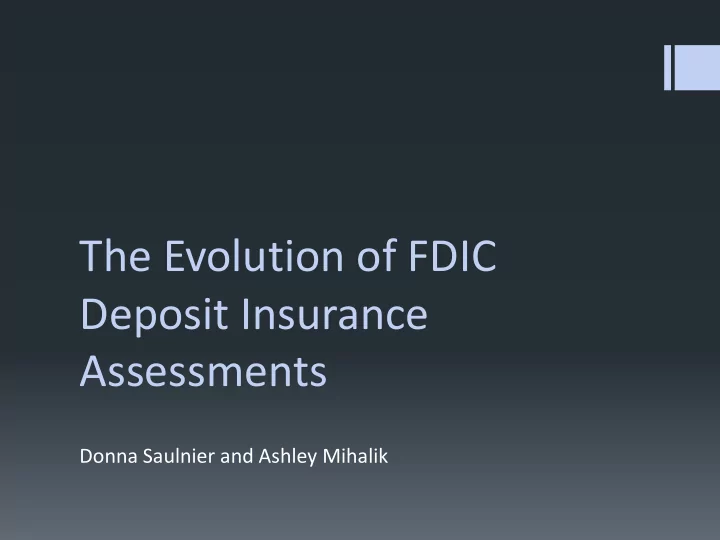

The Evolution of FDIC Deposit Insurance Assessments Donna Saulnier and Ashley Mihalik
2 Learning Objectives The evolution of FDIC assessments The history of invoicing & collection Risk mitigation strategies
3 Original Assessment System Fixed rate – all banks paid a uniform rate Initial nominal assessment rate set = 8.33 bps * domestic deposits Starting in 1950, included rebates Role of fund management
4 Risk-Based Assessments 1993 First risk- 2006 Revisions to 2008 Changes based assessment risk-based pricing during the system Financial Crisis • Separate pricing for large and small • Based on capital • Adjustments for banks levels and liabilities that could supervisory groups affect potential • Financial ratios losses to the DIF predict probability of downgrade
5 Current Assessment System 2010 Dodd-Frank 2011 Large Bank 2016 Small Bank Act Pricing Changes Pricing Changes • Changes to fund • Scorecards for • Based on management large banks and experience during highly complex 2 banking crises • Assessment base banks • Financial ratios • Financial ratios predict probability predict risk ranking of failure
6 Assessment Rate Schedule Established Small Banks Large & Highly CAMELS Composite Rating Complex Institutions 1 or 2 3 4 or 5 Initial Base Assessment Rate 3 to 16 6 to 30 16 to 30 3 to 30 (IBAR) Unsecured Debt Adjustment a -5 to 0 -5 to 0 -5 to 0 -5 to 0 Brokered Deposit Adjustment N/A N/A N/A 0 to 10 Total Base Assessment Rate 1.5 to 16 3 to 30 11 to 30 1.5 to 40 Note: Assessment base equals average consolidated total assets minus average tangible equity, with additional reductions for custodial banks and banker’s banks. a The unsecured debt adjustment is limited to the lesser of 5 basis points or 50 percent of the IBAR; thus, for example, the maximum unsecured debt adjustment for an institution with an IBAR of 5 basis points is 2.5 basis points. The rate schedule shown does not include the depository institution debt adjustment, which increases assessments by 50 basis points for each dollar of long-term unsecured debt held by a bank that was issued by another insured institution, to the extent that the debt exceeds 3 percent of Tier 1 capital.
7 History of Invoicing & Collection Original Paper-Based Process
8 Paper-Based Process Paper forms completed semiannually by banker Similar to IRS tax forms Mailed to FDIC lockbox along with a paper check Required reconciling when checks were posted to the wrong bank > 40% error rate Semiannual error verification process
9 History of Invoicing & Collection Current Electronic Bill Presentment & Collection
10 Electronic Bill Presentment & Collection Invoices prepared by FDIC quarterly using data reported by banks Banks required to review the invoice, to notify FDIC of errors, and to ensure funds are available for payment from a designated account Assessment premiums are collected quarterly via ACH direct debit
11 Risk Mitigation Source system reconcilements Dual-control processes Quarterly internal control self-assessments
12 Risk Mitigation Annual audits by Government Accountability Office (GAO) Structured Compliance Review Programs Assessment Base Reviews High-Risk Asset Reviews
13 For more information… https://www.fdic.gov/deposit/insurance/assessments/
14 Contact Information: Donna Saulnier – dsaulnier@fdic.gov Ashley Mihalik – amihalik@fdic.gov
Recommend
More recommend